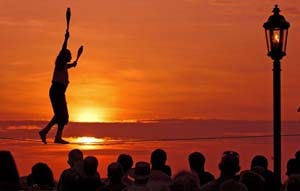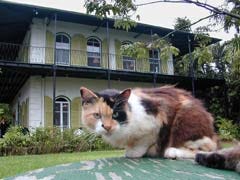Key West — find a laid back lifestyle with loud shirts
Key West is a place to relax, enjoy nature, and party.
Even after spending several days luxuriating in the sun on Key West, the essence of the Florida destination eluded me. I had immersed myself in the tiny island’s history, wandered narrow streets lined by gingerbread houses, and taken in its intriguing sights.
The missing ingredient was provided when I spotted several elderly men playing bocce. I asked another spectator if lawn bowling is popular because many people of Italian descent live in Key West. Chuckling, she replied, “No. It’s popular because you can play bocce with one hand and hold a drink in the other.”
That fun-filled outlook on life sums it up. More than the sun or setting, Key West is an attitude. Life there is laid back and people need little excuse to party.
Even the sunset is a party.
Each evening, a crush of people congregates at Mallory Square as the sun dips toward the horizon. Jugglers, musicians and other entertainers compete for an audience and tips. Many hands clutch a plastic “take-out” cup containing a beverage purchased at a nearby bar. After the sun disappears to the sound of applause, the throng disperses and flows toward the watering holes and restaurants that line nearby Duval Street. Many head for Sloppy Joe’s Bar and Captain Tony’s, both of which claim, with some justification, that Ernest Hemingway used to be a regular patron.
Hemingway lived here — with his cats
Another introduction to one of Key West’s most famous residents awaits at the Spanish Colonial-style home where Hemingway lived with his wife Pauline, one of four, from 1931 to 1939. The tiny second-story studio where Hemingway turned out major novels remains exactly as he left it. A manual typewriter stands on the desk and stuffed heads of animals the author shot on safari adorn the walls. Today’s residents are about four dozen cats, some of them six-toed, which are said to be descendants of the writer’s beloved “Snowball.”
Hemingway wasn’t the only literary giant to be attracted by Key West’s charms. Robert Frost, John Hersey, and Gore Vidal are among others who dropped by for visits. Tennessee Williams owned a modest bungalow there from 1949 until his death in 1983.
President Harry Truman spent most of his vacations here.
Another famous part-time resident was President Harry Truman, who made 11 trips to what became known as the “Little White House.” That wooden two-story building also served as a temporary home to Presidents Eisenhower, Kennedy, and Carter.
More interesting to me was a small museum at the entrance which brings Harry to life as a very real person. For example, it describes the lively poker games and “loud shirt” contests he enjoyed with staff members. It also reports that Harry insisted he drank an early morning “shot of bourbon followed by a large glass of fresh-squeezed Florida orange juice” on the advice of his doctor.
Another small but interesting museum worth a visit is in the East Martello tower, one of four red brick forts that served as a coastal defense in the mid-19th century. Its hodge-podge collection traces the role of pirates, sponging, cigar making and treasure hunting in Key West’s eclectic past.
Shipwrecks and treasures
The search for treasure is dramatically depicted in two other museums. The Mel Fisher Treasure Museum recounts the story of that intrepid fortune hunter. He spent 16 years seeking the wreck of Spanish galleons that sank in 1622 off the coast of Key West during a ferocious hurricane. The $450 million treasure included more than 40 tons of gold and silver as well as emeralds, Chinese porcelain, and other precious artifacts. To me, the story of Mel Fisher’s search for the valuable cache is as fascinating as the exhibits themselves.
The Shipwreck Treasures Museum tells the intriguing story of Key West “wreckers” with a combination of exhibits, audio-visual displays, and a live presentation. Wrecking and salvage — rescuing passengers, then recovering cargoes of ships that sunk following collisions with treacherous offshore reefs — was the foundation of Key West’s economy throughout the 19th century. For a time, that enterprise made the tiny island the richest city per capita in the United States.
If you go
For information about Key West, call (800) 352-5397 or log onto fla-keys.com.
Victor Block
After gallivanting throughout the United States and to more than 75 other countries worldwide and writing about what he sees, does, and learns, Victor Block retains the travel bug. He firmly believes that travel is the best possible education and claims he still has a lot to learn. He loves to explore new destinations and cultures, and his stories about them have won several writing awards.






